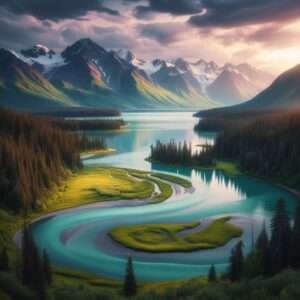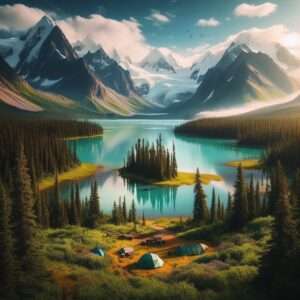Lake Clark National Park and Preserve: 7 Must-See Wonders in Alaska’s Untamed Wilderness
Introduction
Welcome to the untamed wilderness of Lake Clark National Park and Preserve! Nestled within the rugged landscapes of Alaska, this hidden gem beckons adventurers and nature enthusiasts alike to explore its breathtaking beauty. From towering mountains to pristine lakes, this park offers a sanctuary for wildlife and a playground for outdoor enthusiasts.
As you embark on a virtual journey through this remarkable park, prepare to be captivated by its untouched landscapes and diverse ecosystems. Whether you’re an avid hiker seeking remote trails or a wildlife enthusiast hoping to spot grizzly bears roaming free, Lake Clark has something extraordinary to offer every visitor.
Join us as we dive deep into the heart of Lake Clark National Park and Preserve, uncovering its hidden wonders and sharing insider tips for an unforgettable adventure. Get ready to immerse yourself in the beauty of Alaska’s wilderness and discover why Lake Clark is a destination unlike any other.
Attractions in Lake Clark National Park and Preserve:
Displayed in the table below are the leading 25 attractions within Lake Clark National Park and Preserve, highlighting distinctive features that distinguish each site and render it remarkable.
| # | Attraction | What’s Special |
|---|---|---|
| 1 | Lake Clark | Scenic beauty, diverse wildlife, and recreational opportunities. |
| 2 | Katmai National Park and Preserve | Home to the Valley of Ten Thousand Smokes and world-famous brown bears. |
| 3 | Redoubt Volcano | Active volcano with stunning landscapes and wildlife. |
| 4 | Chinitna Bay | Popular bear viewing area along the coast. |
| 5 | Telaquana Lake | Remote wilderness area with excellent fishing and hiking. |
| 6 | Tuxedni Wilderness | Untouched wilderness area with diverse ecosystems. |
| 7 | Silver Salmon Creek | Prime bear viewing location with salmon runs. |
| 8 | Lake Clark Wilderness | Expansive wilderness area with pristine lakes and mountains. |
| 9 | Tlikakila River | Scenic river offering fishing and wildlife viewing. |
| 10 | Chilikadrotna River | Popular for fishing and scenic float trips. |
| 11 | Tanalian Falls | Spectacular waterfall in a remote setting. |
| 12 | Port Alsworth | Gateway to Lake Clark National Park and Preserve. |
| 13 | Chigmit Mountains | Impressive mountain range within the park. |
| 14 | Naknek Lake | Large lake offering fishing and boating opportunities. |
| 15 | Kijik Lake | Remote lake with historical significance. |
| 16 | Neacola Mountains | Remote and rugged mountain range. |
| 17 | Carlson Bay | Scenic bay with opportunities for kayaking and wildlife viewing. |
| 18 | Johnson River | Popular for fishing and river trips. |
| 19 | Tuxedni Bay | Coastal area known for its wildlife and scenery. |
| 20 | Chulitna River | Popular for fishing and scenic float trips. |
| 21 | Clark River | Scenic river offering fishing and wildlife viewing. |
| 22 | Alagnak River | Renowned for salmon fishing and wildlife viewing. |
| 23 | Katmai Pass | Mountain pass providing access to Katmai National Park. |
| 24 | Cook Inlet | Scenic coastal area with views of volcanoes and wildlife. |
| 25 | Mount Iliamna | Stratovolcano with scenic beauty and recreational opportunities. |
General Information:
What is Lake Clark National Park and Preserve?
Lake Clark National Park and Preserve encompasses a vast wilderness area in Alaska, showcasing diverse ecosystems and stunning natural beauty. It provides protection for wildlife and offers opportunities for outdoor recreation and exploration.
Where is Lake Clark National Park and Preserve located?
Lake Clark National Park and Preserve is situated in the southern part of Alaska, bordered by the Alaska Range and the Cook Inlet. It spans over four million acres of pristine wilderness.
Is Lake Clark National Park and Preserve a national park?
Yes, Lake Clark National Park and Preserve is a designated national park, managed by the National Park Service to preserve its ecological and cultural significance.
Resources and Information:
Where can I find a map of Lake Clark National Park and Preserve?
Maps of Lake Clark National Park and Preserve can be obtained from various sources, including the National Park Service website, visitor centers, or online mapping platforms.
Are there any photos available for Lake Clark National Park and Preserve?
Numerous photos capturing the beauty of Lake Clark National Park and Preserve can be found online, including on official park websites, social media platforms, and photography websites.
Activities and Services:
Can I camp at Lake Clark National Park and Preserve?
Yes, camping is permitted in designated areas within Lake Clark National Park and Preserve, offering visitors the opportunity to experience the wilderness firsthand.
How can I obtain tickets for Lake Clark National Park and Preserve?
Lake Clark National Park and Preserve does not require tickets for entry. Visitors can access the park freely, although certain activities or tours may have associated fees.
Are there any guided tours available for Lake Clark National Park and Preserve?
Yes, guided tours led by experienced naturalists are available for those interested in exploring Lake Clark National Park and Preserve. These tours offer insights into the park’s wildlife, history, and natural features.
Where can I rent an RV for Lake Clark National Park and Preserve?
RV rentals can be arranged through various rental agencies in nearby towns or cities, providing visitors with the flexibility to explore the park at their own pace.

Discovering the Wonders: 10 Fascinating Facts about Lake Clark National Park and Preserve
Remote Wilderness: Lake Clark National Park and Preserve stands as a testament to the untouched beauty of nature, offering a retreat from the hustle and bustle of modern life. Tucked away in the remote reaches of Alaska, this park remains one of the least-visited national parks in the United States, providing visitors with a rare opportunity to immerse themselves in pristine wilderness far from the crowds. Here, the tranquility of the natural world reigns supreme, with vast expanses of untouched landscapes waiting to be explored. Whether you’re gazing out over the rugged coastline, hiking through dense forests, or marveling at the towering peaks of the Alaska Range, Lake Clark offers a sense of solitude and serenity that is truly unparalleled.
Diverse Ecosystems: One of the most remarkable aspects of Lake Clark National Park and Preserve is its incredible diversity of ecosystems. Spanning over four million acres, the park encompasses a wide range of habitats, from coastal rainforests and glaciers to tundra and volcanic landscapes. This diversity of environments provides a home for an astonishing array of plant and animal species, each adapted to thrive in its own unique niche. From the lush vegetation of the temperate rainforest to the stark beauty of the alpine tundra, every corner of Lake Clark is teeming with life, offering endless opportunities for exploration and discovery.
Grizzly Bears Galore: Lake Clark National Park and Preserve is renowned for its abundant population of grizzly bears, which roam freely throughout the park’s rugged terrain. For wildlife enthusiasts, encountering one of these majestic creatures in the wild is an unforgettable experience, offering a rare glimpse into the natural behavior of one of North America’s most iconic animals. Whether feasting on salmon in the park’s rivers and streams or foraging for berries on the hillsides, grizzly bears play a vital role in the ecosystem of Lake Clark, serving as both predator and prey in this wild and untamed landscape.
Salmon Spectacle: Every summer, millions of salmon return to the rivers and streams of Lake Clark National Park and Preserve, embarking on an epic journey from the ocean to their spawning grounds. This annual spectacle of nature is a key event in the park’s ecosystem, attracting not only grizzly bears but also bald eagles, otters, and other wildlife that depend on the bounty of the salmon run for their survival. For visitors, witnessing this incredible display of nature’s power and resilience is a humbling experience, reminding us of the interconnectedness of all life and the importance of protecting the wild places that sustain us.
Cultural Heritage: Beyond its natural beauty, Lake Clark National Park and Preserve is also rich in cultural history, with evidence of human habitation dating back over 10,000 years. The park’s archaeological sites and cultural landmarks offer a glimpse into the lives of the indigenous peoples who have called this land home for millennia, showcasing their deep connection to the land and the resources it provides. Today, the park works closely with local communities to preserve and protect these cultural treasures, ensuring that their legacy lives on for future generations to appreciate and learn from.
Volcanic Legacy: Lake Clark National Park and Preserve is home to a number of active volcanoes, including the iconic Mount Redoubt, whose eruptions have shaped the landscape and left a lasting imprint on the park’s environment. These volcanic peaks serve as a reminder of the dynamic forces at work beneath the Earth’s surface, shaping the land and influencing the ecosystems that call it home. While the threat of volcanic activity looms large, it also adds to the park’s allure, attracting geologists, adventurers, and curious visitors eager to witness the raw power of nature in action.
Turquoise Treasures: One of the most striking features of Lake Clark National Park and Preserve is its stunning turquoise-colored lakes, which dot the rugged landscape like precious jewels. These pristine bodies of water are not only a feast for the eyes but also a haven for outdoor enthusiasts, offering opportunities for kayaking, fishing, and photography. Whether paddling across the crystal-clear waters, casting a line in search of trophy-sized fish, or capturing the breathtaking scenery on camera, visitors to Lake Clark are sure to be mesmerized by the beauty of these turquoise treasures.
Wilderness Adventures: With over 2.6 million acres of designated wilderness, Lake Clark National Park and Preserve is a paradise for outdoor adventurers seeking solitude and serenity amid the natural world. From rugged mountains to remote valleys, the park offers endless opportunities for hiking, backpacking, camping, and exploration off the beaten path. Whether embarking on a multi-day trek through the backcountry or simply taking a leisurely stroll along one of the park’s many trails, visitors are sure to be rewarded with breathtaking views, pristine landscapes, and a sense of wonder that can only be found in the wild.
Flightseeing Paradise: Accessible only by small aircraft or boat, Lake Clark National Park and Preserve offers a unique perspective on its vast and varied landscapes from the air. Flightseeing tours provide visitors with the opportunity to soar above the park’s rugged terrain, offering unparalleled views of its towering peaks, turquoise lakes, and winding rivers. Whether taking a scenic flight over the Alaska Range or landing on a remote beach to explore on foot, flightseeing is a thrilling and unforgettable way to experience the beauty of Lake Clark from a whole new angle.
Conservation Efforts: Lake Clark National Park and Preserve is dedicated to preserving its pristine wilderness and fragile ecosystems for future generations, serving as a beacon of conservation and stewardship in the Alaskan wilderness. Through research, education, and outreach efforts, the park works tirelessly to protect its natural resources, minimize human impact, and promote sustainable practices that ensure the long-term health and vitality of this unique and precious landscape. By preserving Lake Clark for generations to come, we not only safeguard its ecological and cultural heritage but also provide a sanctuary for wildlife and a place of wonder and inspiration for all who visit.
Your Comprehensive Tourist Guide: Top 10 Must-Know Tips for Visiting Lake Clark National Park and Preserve
Plan Ahead: Start your journey by thoroughly researching the park’s attractions, regulations, and available amenities. Understanding what Lake Clark National Park and Preserve offers will help you tailor your experience to your preferences.
Pack Appropriately: Alaska’s weather can be unpredictable, so it’s crucial to pack accordingly. Bring layers, waterproof clothing, sturdy hiking boots, sunscreen, insect repellent, and plenty of water. Packing essentials ensures you’re prepared for any weather conditions or outdoor activities you encounter.
Stay Informed: Keep yourself updated on the latest park information, including weather forecasts, trail conditions, and any wildlife advisories. Check the park’s official website or contact the visitor center before your trip for the most accurate information.
Respect Wildlife: Lake Clark is home to diverse wildlife, including grizzly bears, moose, and bald eagles. While observing wildlife, maintain a safe distance and never approach or feed them. Adhering to park guidelines ensures both your safety and the well-being of the animals.
Leave No Trace: Preserve the park’s natural beauty by following Leave No Trace principles. Pack out all trash, stay on designated trails, and avoid disturbing plants or wildlife. Leave the wilderness as you found it to protect it for future generations.
Be Bear Aware: Familiarize yourself with bear safety protocols before embarking on any outdoor activities. Carry bear spray, make noise while hiking to alert bears of your presence, and properly store food to prevent attracting bears to your campsite.
Enjoy Outdoor Activities: Lake Clark offers a wide range of recreational opportunities, from hiking and backpacking to fishing and wildlife viewing. Take advantage of these activities to immerse yourself in the park’s natural beauty and diverse ecosystems.
Take Precautions: Prioritize safety during your visit by carrying essential items such as a first-aid kit, map, compass or GPS device, and emergency whistle. Being prepared for emergencies ensures you can handle unexpected situations effectively.
Respect Park Regulations: Familiarize yourself with park rules and regulations to ensure a smooth and enjoyable visit. This includes adhering to camping regulations, observing wildlife viewing guidelines, and following any posted signs or closures.
Embrace the Experience: Finally, embrace the unique experience of visiting Lake Clark National Park and Preserve. Immerse yourself in the stunning landscapes, connect with nature, and create lasting memories as you explore one of Alaska’s most spectacular wilderness areas.

Top 10 FAQs: Your Essential Guide to Lake Clark National Park and Preserve
What is Lake Clark National Park and Preserve?
Lake Clark National Park and Preserve is a protected area located in Alaska, renowned for its pristine wilderness, diverse ecosystems, and rich cultural heritage. Spanning over four million acres, it encompasses rugged mountains, turquoise lakes, and abundant wildlife.
How do I get to Lake Clark National Park and Preserve?
Access to Lake Clark is primarily by air or water, as there are no roads leading directly to the park. Visitors typically fly into nearby communities like Port Alsworth, Homer, or Anchorage, then arrange for a charter flight or boat transport to reach the park.
What activities can I do in Lake Clark National Park and Preserve?
Lake Clark offers a wide range of outdoor activities, including hiking, camping, fishing, wildlife viewing, kayaking, rafting, and flightseeing. Whether you’re an avid adventurer or a nature enthusiast, there’s something for everyone to enjoy in the park.
Are there camping facilities in Lake Clark National Park and Preserve?
Yes, camping is permitted in designated areas throughout the park. There are established campgrounds with basic amenities, as well as opportunities for backcountry camping for those seeking a more remote experience.
What wildlife can I expect to see in Lake Clark National Park and Preserve?
Lake Clark is home to a diverse array of wildlife, including grizzly bears, moose, wolves, bald eagles, salmon, and more. Visitors have the chance to observe these animals in their natural habitat and learn about their behaviors and habitats.
Are guided tours available in Lake Clark National Park and Preserve?
Yes, several companies offer guided tours and excursions in Lake Clark, ranging from wildlife viewing and bear watching tours to fishing charters and scenic flights. These guided experiences provide valuable insights into the park’s ecology and history.
Can I fish in Lake Clark National Park and Preserve?
Yes, fishing is permitted in Lake Clark, subject to state regulations and license requirements. The park’s rivers and lakes offer excellent fishing opportunities for various species, including salmon, trout, char, and grayling.
Is lodging available in Lake Clark National Park and Preserve?
Lodging options within the park are limited, but there are a few lodges, cabins, and backcountry shelters available for rent. Many visitors choose to stay in nearby communities or camp in the park.
When is the best time to visit Lake Clark National Park and Preserve?
The best time to visit Lake Clark depends on your interests and preferences. Summer months (June to August) offer pleasant weather and longer daylight hours, while shoulder seasons like spring and fall provide opportunities for fewer crowds and unique experiences.
What safety precautions should I take when visiting Lake Clark National Park and Preserve?
Visitors should be prepared for the wilderness and take necessary precautions, such as carrying bear spray, making noise while hiking, properly storing food, and being aware of weather conditions and potential hazards. Additionally, respecting wildlife and following park regulations contribute to a safe and enjoyable experience.
You may also consider discovering information about Grand Teton National Park.


